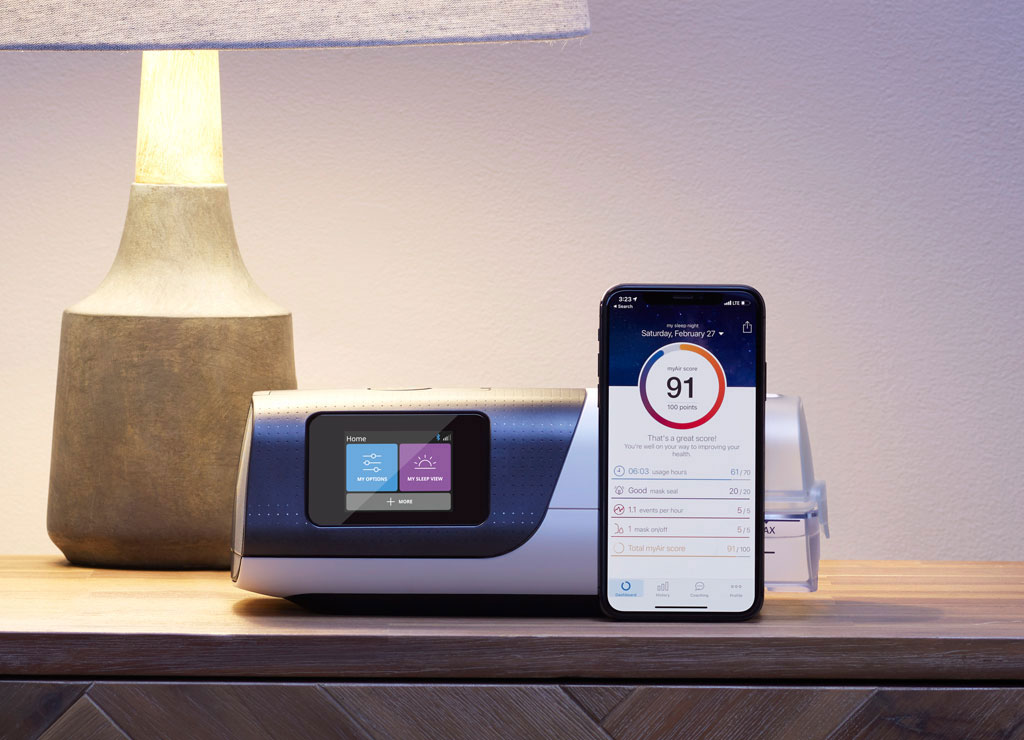CPAP & Sleep Apnea Solutions:
Our team of respiratory therapists provides personalized guidance on CPAP (continuous positive airway pressure) machines, the gold standard for sleep apnea treatment. We’ll help you:
- Understand how CPAP machines work and teach you how to use them
- Choose the right CPAP equipment components, including the pump, tubing, and mask
- Adjust the machine to the proper settings according to your prescription
What Is a CPAP Machine?
There are several types of sleep therapy machines, but a CPAP machine is the most common. It’s designed to send a constant flow of airway pressure to your throat to ensure your airway stays open during sleep, effectively treating the spontaneous pauses in breathing associated with sleep apnea.
Learn more about sleep apnea, its symptoms, diagnosis and what steps you should be taking to get sleep apnea treatment.

What Components Does a CPAP Machine Have?
A CPAP machine has a pump that controls the airflow, a tube that carries the air from the machine to you, and a mask that goes over your mouth, nose or both. There are three common types of masks, including:
- Nasal Masks: A nasal mask covers the nose only. It's ideal for individuals who breathe through their nose during sleep and offers a comfortable fit and clear field of vision.
- Nasal Pillow Masks: A nasal pillow mask fits under your nose and inserts small pillows or cushions into the nostrils. This is suitable for those who prefer minimal facial contact. It’s lightweight and less intrusive, providing a more open feel.
- Full Face Masks: A full face mask covers both the nose and mouth. It’s recommended for individuals who breathe through their mouth or require higher pressure settings. It ensures effective therapy for both nose and mouth breathers.
CPAP Product FAQs
What is a CPAP machine?
A CPAP (Continuous Positive Airway Pressure) machine is a device commonly used to treat sleep apnea. It sends a constant flow of airway pressure to your throat to keep your airway open during sleep, preventing spontaneous pauses in breathing.
How does a CPAP machine work?
A CPAP machine works by delivering a steady stream of air through a mask, which keeps the airway open and ensures uninterrupted breathing throughout the night.
What components does a CPAP machine have?
A CPAP machine typically includes:
- Pump: Controls the airflow.
- Tube: Carries the air from the machine to the mask.
- Mask: Comes in three types:
What types of masks can I used with a CPAP device?
- Nasal Masks: Cover the nose only, ideal for nose breathers.
- Nasal Pillow Masks: Fit under the nose with small pillows or cushions inserted into the nostrils, suitable for minimal facial contact.
- Full Face Masks: Cover both the nose and mouth, recommended for mouth breathers or those requiring higher pressure settings.
How do I choose the right CPAP equipment?
Choosing the right CPAP equipment involves selecting the appropriate pump, tubing, and mask based on your specific needs and preferences. Consulting with a respiratory therapist can help you make the best choice.
How do I adjust my CPAP machine to the proper settings?
Your CPAP machine should be adjusted according to your prescription. A respiratory therapist can guide you through the process to ensure the settings are correct for effective therapy.
What should I know about sleep apnea?
Sleep apnea is a condition characterized by spontaneous pauses in breathing during sleep. Symptoms include loud snoring, daytime fatigue, and restless sleep. Diagnosis and treatment are essential for managing this condition effectively.
What are the different types of PAP devices?
There are three main types of Positive Airway Pressure (PAP) devices used to treat sleep apnea
- CPAP (Continuous Positive Airway Pressure): Delivers a constant, steady pressure of air to keep the airway open.
- BiPAP (Bilevel Positive Airway Pressure): Provides two levels of pressure – a higher pressure when you inhale and a lower pressure when you exhale. This is often used for patients who have difficulty tolerating CPAP.
- APAP (Automatic Positive Airway Pressure): Automatically adjusts the pressure throughout the night based on your needs, providing the minimum pressure required to keep the airway open.
